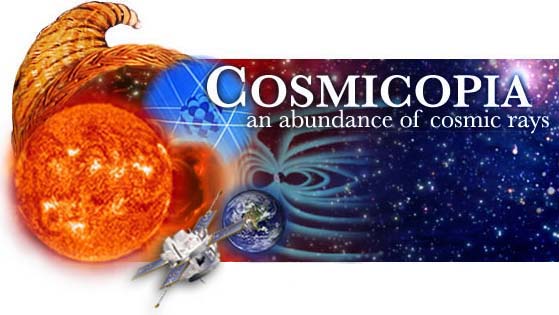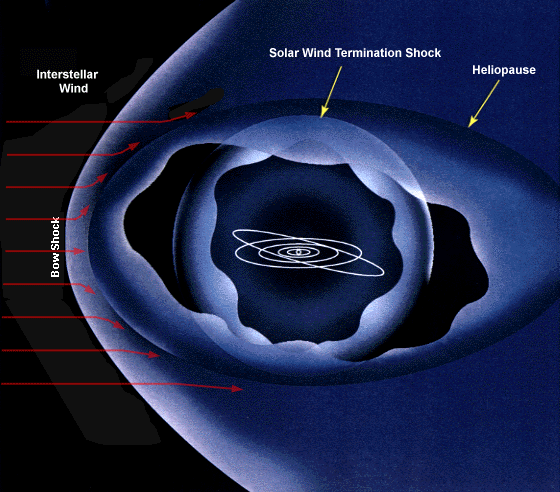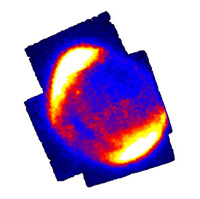
The Heliosphere
The heliosphere is the immense magnetic bubble containing our solar system, solar wind, and the entire solar magnetic field. It extends well beyond the orbit of Pluto. While the density of particles in the heliosphere is very low (it's a much better vacuum than is created in a laboratory), it is full of particles of interest to heliospheric scientists. Check out the image below for a diagram of the heliosphere.
More about the Sun's magnetic field...
The solar wind near our Sun's surface contains alternating streams of high and low speed. These streams corotate with the Sun, that is, they rotate along with it. The high-speed streams originate in coronal holes and extend toward the solar poles; the low-speed streams come from near the Sun's equator. There are compositional differences between the high and low speed streams of the solar wind.
 With increasing distance from the Sun, the high-speed streams overtake the slower plasma, producing corotating interaction regions (CIRs) on their leading edges. CIRs are bounded by two shocks at the front and rear edges called the forward and reverse shocks. At these shocks, the density, pressure, and magnetic field strength are all higher. These regions are quite effective as energetic particle accelerators. When ions that have been accelerated at a CIR are observed, they are called corotating ion events.
With increasing distance from the Sun, the high-speed streams overtake the slower plasma, producing corotating interaction regions (CIRs) on their leading edges. CIRs are bounded by two shocks at the front and rear edges called the forward and reverse shocks. At these shocks, the density, pressure, and magnetic field strength are all higher. These regions are quite effective as energetic particle accelerators. When ions that have been accelerated at a CIR are observed, they are called corotating ion events.
Energetic storm particles (ESPs), accelerated by shocks associated with solar flares and CMEs, are another example of interplanetary acceleration.
The heliopause is the name for the blurred boundary between the heliosphere and the interstellar gas outside the solar system. As the solar wind approaches the heliopause, it slows suddenly, forming a shock wave. This solar wind termination shock is exceptionally good at accelerating particles.
 The Heliosphere in the News:
The Heliosphere in the News:
October 19, 2008: NASA launches IBEX mission to outer Solar System -- NASA
October 6, 2008: NASA spacecraft ready to explore outer Solar System -- NASA
July 25, 2008: 'Impressionist' spacecraft to view solar system's invisible frontier -- NASA
July 9, 2008: Voyager 2 finds edge of solar system more complex than predicted -- JHU APL
July 2, 2008: STEREO creates first images of the solar system's invisible frontier -- NASA
July 2, 2008: Who knew? Solar system is 'dented', not round -- CNN
February 22, 2008: International solar mission to end following stellar performance -- NASA
January 18, 2008: Abundances and energy spectra of CIR heavy ions during Solar Cycle 23 -- ACE News
December 13, 2007: Voyager 2 reaches the heliosphere -- AIP
December 12, 2007: Surprises at the solar system's edge -- Astronomy.com
December 10, 2007: Voyager 2 probe leaves the neighborhood -- Nature
December 10, 2007: MIT instrument finds surprises at solar system's edge -- MIT
November 28, 2007: Voyager 2 nears threshold at edge of solar system -- Canadian Broadcasting Company
August 31, 2007: Celebrating 10 years of ACE in space -- ACE News
August 30, 2007: Pioneering NASA spacecraft mark thirty years of flight -- Science Daily
August 20, 2007: Pioneering NASA spacecraft mark thirty years of flight -- NASA JPL
August 17, 2007: In search of interstellar dragon fire -- NASA GSFC
November 17, 2006: Ulysses embarks on third set of polar passes -- European Space Agency
November 16, 2006: Learning the magnetic ropes -- Los Alamos National Laboratory
September 21, 2006: Surprises from the edge of the solar system -- Science@NASA
May 23, 2006: Voyager 2 detects odd shape of solar system's edge -- Space.com
May 23, 2006: Voyager: living on the edge - of the solar system -- NASA JPL
October 7, 2005: Ulysses, fifteen years and going strong -- SpaceRef.com
September 27, 2005: Voyager finds three surprises near our solar system's edge -- PhysOrg.com
September 26, 2005: Voyager 1: messages from the edge -- SpaceRef.com
June 2, 2005: Voyager 1 at solar system edge, scientists now agree -- National Geographic News
May 27, 2005: Reaching the solar system's edge -- Astronomy.com
May 24, 2005: Voyager spacecraft enters solar system's final frontier -- NASA JPL
March 15, 2005: The distortion of the heliosphere: our interstellar magnetic compass -- SpaceRef.com
March 3, 2005: NASA study suggests giant space clouds iced Earth -- NASA HQ
October 9, 2004: The flow of interstellar helium in the solar system -- SpaceRef.com
September 27, 2004: Shields up! -- Science@NASA
September 20, 2004: The flow of interstellar helium in the solar system -- European Space Agency
July 9, 2004: Blast waves near edge of system -- Florida Today
July 8, 2004: Spacecraft fleet tracks blast wave through solar system -- NASA GSFC
February 14, 2004: Ulysses mission extended -- Spaceflight Now
January 3, 2004: Next stop, interstellar space -- Science News
November 20, 2003: Voyager at 90 AU -- NASA GSFC APOD
November 5, 2003: What does the edge of the solar system look like? Ask Voyager. -- NASA
November 5, 2003: Voyager spacecraft approaches solar system's final frontier -- NASA JPL
September 22, 2003: Merged Interaction Regions (MIRs) at 1 AU -- ACE News
July 17, 2003: Interstellar and heliospheric parameters derived from observations of pickup helium in the focusing cone -- ACE News
April 9, 2003: Maintenance on Voyager from 7 billion miles away -- Spaceflight Now
January 2: Suprathermal electrons in high-speed streams -- ACE News
August 16, 2002: 25 years later, Voyager mission keeps pushing the space envelope -- NASA JPL
July 22, 2002: The little spacecraft that could...and did -- Scientific American
June 24, 2002: The Sun's heliosphere & heliopause -- NASA GSFC APOD
April 18, 2002: Beyond Pluto, NASA craft keeps on trekking -- CNN.com
April 9, 2002: Record set for most-distant spacecraft maintenance -- NASA JPL
March 13, 2002: LL Orionis: When cosmic winds collide -- NASA GSFC APOD
March 6, 2002: Hubble eyes bow shock near a young star -- NASA JPL
October 11, 2001: Ulysses reaches the Sun's north pole -- ESA
December 19, 2000: Most distant spacecraft may reach shock zone soon -- Spaceflight Now
December 18, 2000: Most distant spacecraft may reach shock zone soon -- NASA JPL
November 28, 2000: BZ Cam bow shock -- NASA GSFC APOD
October 17, 2000: Gemini North images bow shock near galactic center -- NASA GSFC APOD
September 6, 2000: Ulysses studies the Sun's polar cap at sunspot maximum -- NASA JPL
June 15, 2000: Officials seek to extend Ulysses sun probe mission -- Spaceflight Now






Questions and comments to: cosmicopia@cosmicra.gsfc.nasa.gov
Curator: Beth Barbier, SP Systems
Responsible NASA Official: Dr. Tycho von Rosenvinge
Privacy Policy and Important Notices

HOME
In the News
History
Ask Us
Great Links
Glossary
Site Map
Search NASA